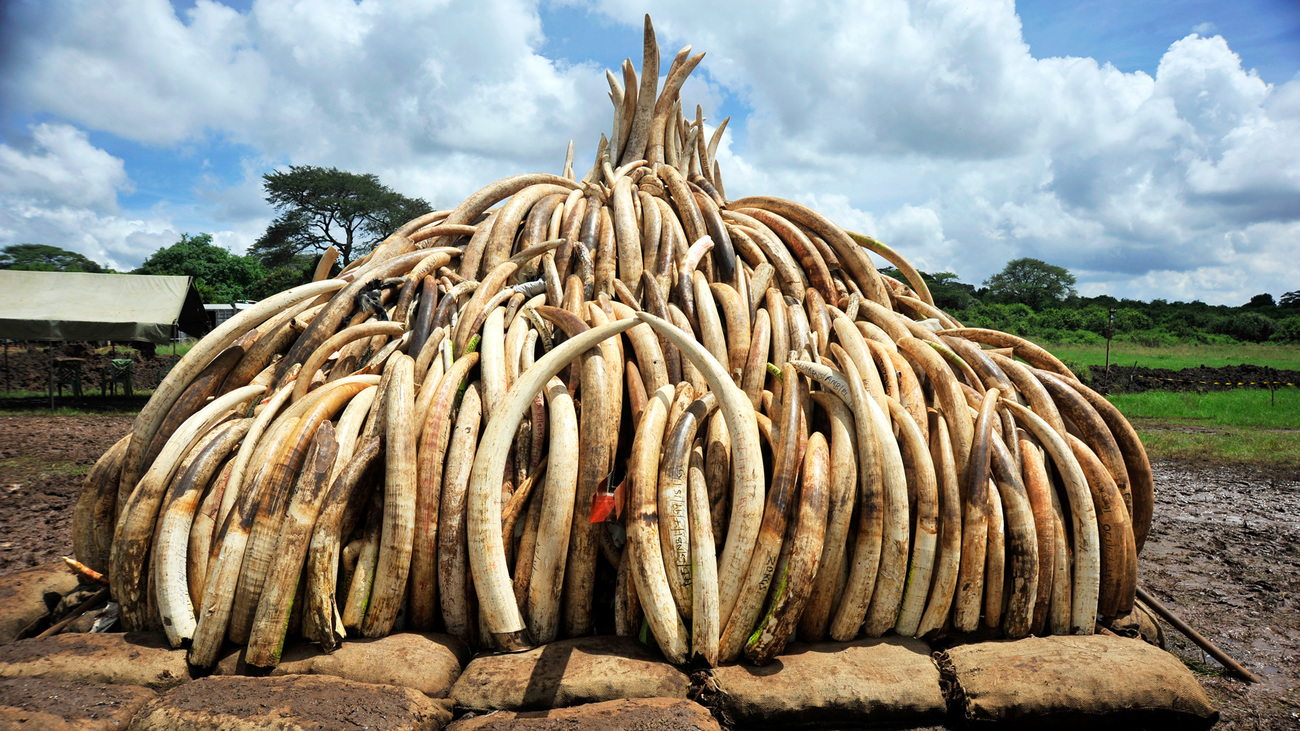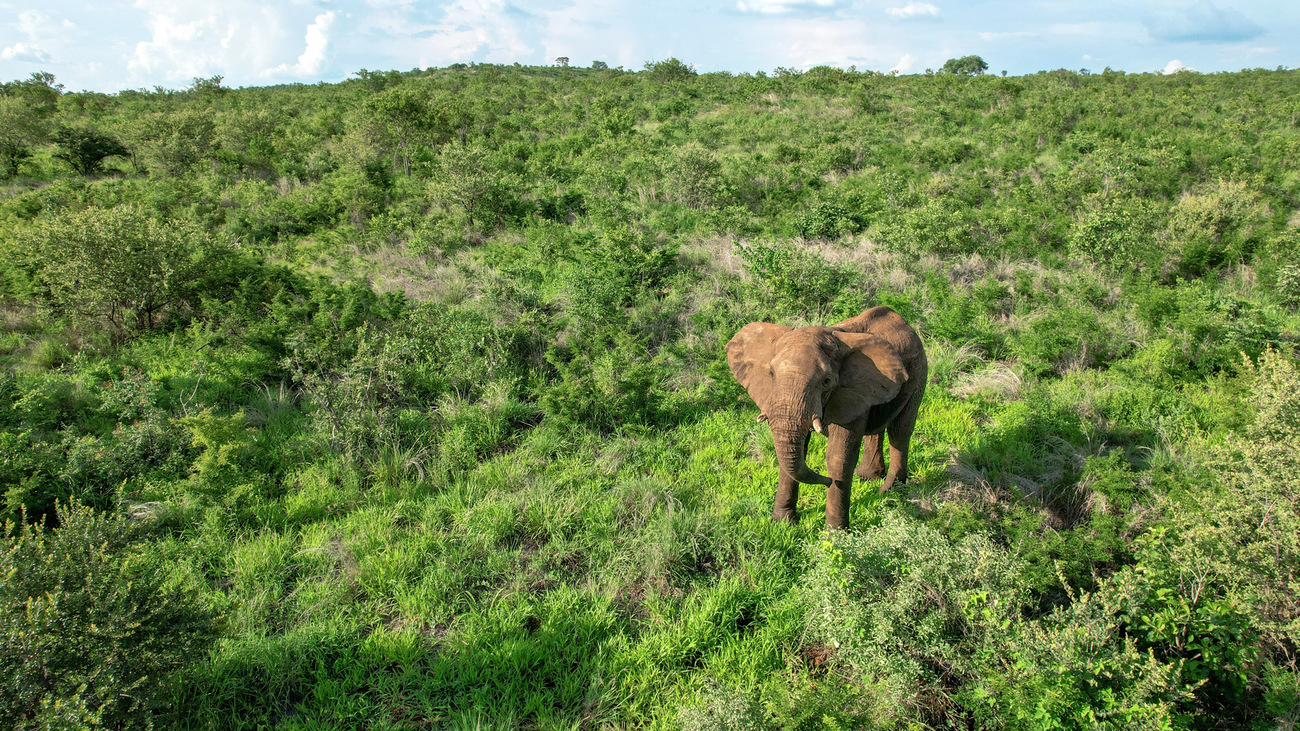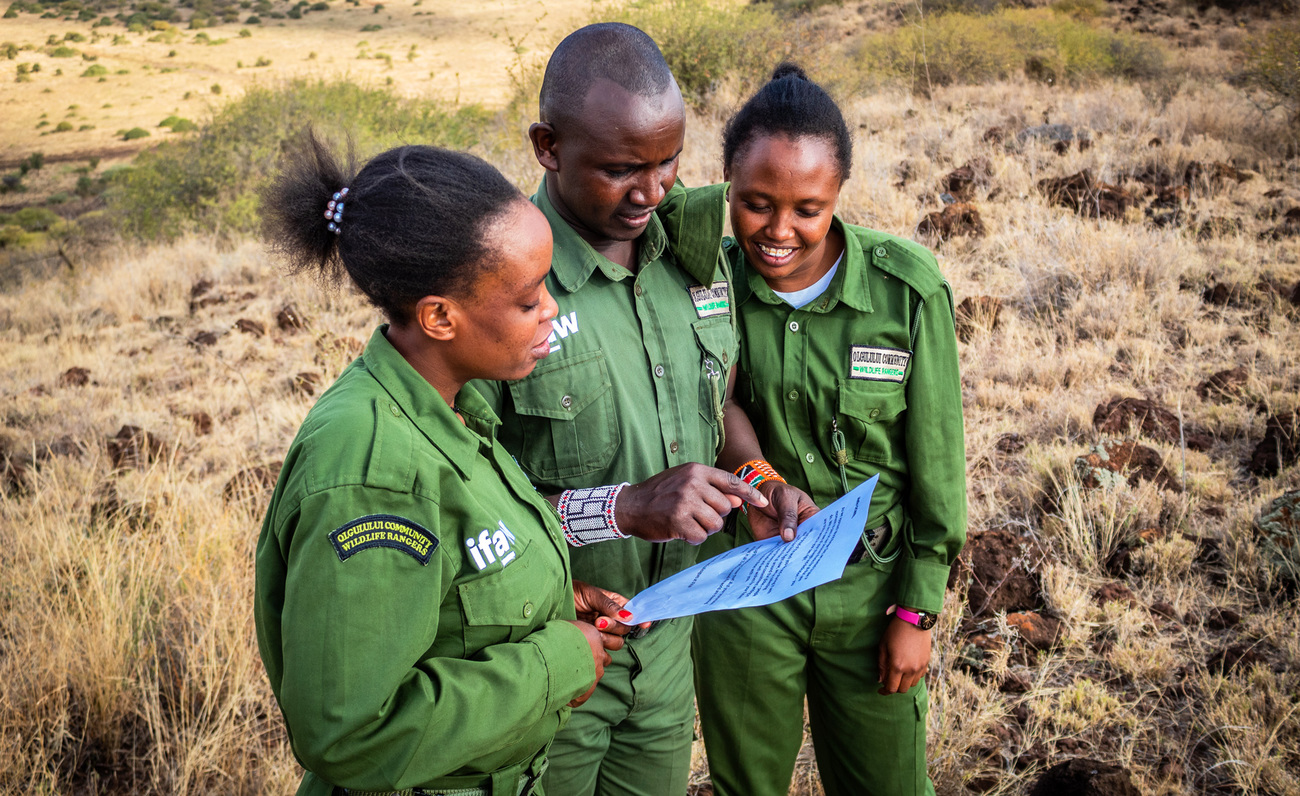Elephant poaching: Why it’s a big problem
Elephant poaching: Why it’s a big problem
Elephants, known for their intelligence, size, and distinct appearance, face a major threat from poaching—an illegal practice driven by the demand for ivory and other elephant products. They are one of the most heavily poached mammals in the world, with a staggering 90% of African elephants being killed by poachers within the last 100 years.

Poaching endangers individual elephants and the wider species, destabilizes entire ecosystems, and poses a significant challenge to global biodiversity efforts.
IFAW is an organization dedicated to conservation and rescue around the world. A core part of our work involves anti-poaching initiatives to protect elephants in Africa and Asia.
In this article, we’ll explore elephant poaching, its causes, impacts, and ongoing efforts to combat this devastating practice.
What is poaching?
Poaching is the term used to describe the illegal hunting, killing, or live capturing of wild animals, usually for commercial gain. This could be for a particular body part, such as their fur, horns, tusks, teeth, meat, skin, etc., or for the live animal trade. Poaching threatens the survival of many species around the world.
Elephants in particular are targeted for their ivory tusks, which are in particularly high demand in illegal wildlife trade. Unfortunately, there has been a recent surge in elephant poaching. In Botswana—which was once considered to be a sanctuary for wildlife—poachers are carrying out illegal hunting within the national parks. They are often targeting ‘big tusker’ elephants, which are males with the largest ivory tusks to offer.
Why are elephants poached?

Elephant poaching is usually driven by a demand for their tusks. Elephant tusks are made out of ivory. Ivory is in high demand in various parts of the world, particularly in Asia, where it is used for ornaments, jewellery, and traditional medicine.
A 2023 study by the Center for Advanced Defense Studies (C4ADS) found that geographical patterns of elephant ivory continue to adhere to Africa-to-Asia trafficking routes, meaning elephants are being poached for their tusks in African countries and being illegally transported overseas to supply the demand in Asian countries.
Poaching is a complicated issue that often arises from a lack of income sources for people who live close to wildlife. A 2019 study found that elephant poaching increases where there is a lack of income-generating opportunities. In a 2017 survey, 164 out of 173 respondents who admitted to poaching said they would stop poaching if they had income to support their families.
Human-wildlife conflict can also be a source of tension between humans and elephants, which can lead to humans ignoring legal measures taken to protect the species. Where elephants may destroy crops and agriculture, it can lead to humans killing or harming the animals to protect their livelihoods or in retaliation.
As a conservation organization, IFAW works to actively create and support alternative livelihood opportunities for communities where poaching may be an issue. Some examples of our work include the Jenga Mama project in Kenya, which provides vocational training to Maasai women and helps them start their own small businesses, and the Chikolongo Livelihood Project in Malawi, which ensured access to clean water, established a community fish farm, and developed an incentive system to encourage the growth of commercial crops. We also support a project in Zambia alongside COMACO, which trains farmers in sustainable, climate-smart agricultural techniques to support their livelihoods.
Where is elephant poaching a problem?
In 2021, an elephant conservation programme Monitoring the Illegal Killing of Elephants (MIKE), found that around 40% of elephant deaths were due to poaching. Here’s a breakdown of how poaching affects each individual elephant species.
African elephants
African elephants were originally treated as one species, but as of 2021, they are now recognised as two separate species: the African forest elephant and the African savannah elephant. Both species saw steep declines in their populations when poaching surged in 2008. This surge in illegal elephant hunting peaked around 2011, though it continues to threaten African elephant populations today. In 2016, the African Elephant Status Report estimated that 415,428 African elephants lived across the continent, with a decline of approximately 110,000 individuals over the previous decade. Their combined estimated population as of 2021 is 415,000 elephants.
According to the 2023 report by C4ADS, the most common countries of origin for shipments of elephant ivory seized from traffickers were Ethiopia (18.4%), Nigeria (17.6%), Democratic Republic of the Congo (8.8%), and Mozambique (8.8%). However, these countries where the shipment originated do not necessarily reflect where the elephants were initially poached, as many of these countries have much sparser or nonexistent elephant populations in comparison to southern African states. For instance, the report suggests that the prevalence of Mozambique and Angola as countries of shipment origin is likely due to the volume of poaching occurring in neighbouring countries, such as Namibia and South Africa.
African forest elephants
African forest elephants (Loxodonta cyclotis) face immense threats from poaching, which is the primary cause of death for the species. They are found in the dense rainforests of Central and West Africa, including Cameroon, Gabon, the Republic of the Congo, Central African Republic, Equatorial Guinea, Côte d'Ivoire, Liberia, and Ghana. Poachers often exploit remote and difficult-to-monitor forest habitats, targeting these elephants despite protective measures.
Over a period of 31 years, the African forest elephant population declined by more than 86%. Their population is decreasing, but it’s not currently known exactly how many mature individuals exist in the wild. The IUCN Red List classifies the species as critically endangered.
African savannah elephants
African savannah elephants (Loxodonta africana), sometimes called African bush elephants, also face severe threats from widespread poaching activities. These elephants inhabit the savannahs and grasslands of East and southern Africa, specifically in Botswana, Kenya, Namibia, South Africa, Tanzania, Zambia, and Zimbabwe. Increased industrial activity, such as mining, close to African elephants has been shown to lead to an increase in elephant poaching.
Historically, African savannah elephants have been poached not only for their ivory tusks but also for their meat. Over the last 50 years, the population of African savannah elephants has decreased by at least 60%.
According to the IUCN Red List, the African savannah elephant population is continuing to decline, though the exact number of mature individuals is unknown. They are listed as an endangered species.
Asian elephants
Though they are less at risk of poaching than their African counterparts, Asian elephants (Elephas maximus) still face significant threats from poaching, as well as habitat loss, and human-wildlife conflict. Asian elephants are found across the tropical and subtropical forests of Asia, more specifically in the countries of India, Sri Lanka, Myanmar, Thailand, Cambodia, Laos, Vietnam, Malaysia, Indonesia, and China.
In the past, Asian elephants were often poached for their tusks, but in the past 10+ years, they’ve been poached more for their skin and meat for traditional medicine and decorative purposes. Asian elephants often don’t have tusks, and their tusks aren’t as large as their African counterparts. These animal products are used in medicinal products, jewellery, and furniture. This leads to indiscriminate killing, where it’s not only larger males that are being targeted for larger tusks, but females and calves, too.
When carrying out an unrelated study in which they were tracking elephants, scientists from the Smithsonian Conservation Biology Institute (SCBI) found that, though they are at a lower risk than African elephants, Asian elephants are still being poached at an alarming rate. Out of 19 elephants that were tagged for tracking purposes, seven were poached. One elephant was poached within six days of being tagged.
In Myanmar, poaching activity is on the rise. In 2016, 25 elephants were poached in the country, whereas previously, only 61 elephants had been poached in the entire five years prior.
In 2018, it was estimated that 48,323 to 51,680 individual Asian elephants existed in the wild, though those numbers are disputed. Asian elephants are listed on the IUCN Red List as an endangered species. Although it’s not known exactly how many mature individuals still remain in the wild, their population is thought to be decreasing overall.
What is the impact of elephant poaching?

The impact of elephant poaching extends far beyond the loss of individual animals. Elephants are a keystone species, playing critical roles in their ecosystems.
Not only do they help to physically shape their habitats and local ecosystems by creating clearings in forests, dispersing seeds, and creating pathways for other animals, but they’re also culturally significant and symbolic of wisdom, strength, and spirituality for many communities.
It appears that intense poaching activities have also begun to alter the genetics of the African elephant species. As elephants with smaller tusks or no tusks are less likely to be killed by poachers, they’re more likely to survive and reproduce, passing down their tuskless genetics to the next generation. This process of artificial selection will hurt future generations, as elephants evolved their tusks to be used as tools for survival. They often use their tusks to dig, forage, and even defend themselves against predators. Without them, the species may be more vulnerable.
The 2023 study by C4ADS found that as of 2023, the average weight of elephant ivory seized by authorities from traffickers has increased since 2020. The researchers interpret this as a sign that traffickers are becoming more confident in their ability to transport ivory without getting caught, as well as their operations’ ability to take the hit of larger losses. They also report that seizure weight is strongly tied to the complexity of trafficking networks—the larger the shipments, the more complex the networks are behind them.
How can you help prevent elephant poaching?
Everyone can play their part in stopping and preventing wildlife crime. This can range from avoiding purchasing wildlife products to helping to drive down demand to supporting conservation efforts. You can even keep an eye out for illegal wildlife trading activity online and report it to online platforms, local authorities, or conservation organizations.
Sharing this article and educating your social circle about poaching and why it’s a problem also helps spread awareness of the issue, which is important for demand reduction efforts and the deplatforming of online wildlife crime.
Donating to IFAW helps support our work that directly protects elephants and their habitats.
How IFAW works to protect elephants from poaching

In 2013, poachers carried out a devastating cyanide poisoning incident in Zimbabwe's Hwange National Park, killing around 300 elephants. This tragedy was a wake-up call for park rangers and conservationists. Enhanced law enforcement, supported by organizations like IFAW, played a pivotal role in reducing poaching incidents, with the Zimbabwe Parks and Wildlife Management Authority (ZimParks) reporting zero recorded elephant poaching cases in the IFAW-supported areas of Hwange over the past two years.
The establishment of the Makona ranger station, part of a larger conservation initiative with IFAW, marked a significant milestone in transforming the region from a poaching hotspot into a safe haven for wildlife. This initiative includes enhanced ranger welfare, improved patrol capabilities, and sustainable infrastructure, demonstrating our steadfast commitment to safeguarding Zimbabwe’s wildlife for future generations.
In Kenya, Team Lioness, an all-women ranger unit, addresses the underrepresentation of Maasai women in conservation roles. Selected for their leadership, academic achievements, and integrity, the team of 17 Maasai women operates under the Olgulului Community Wildlife Rangers near Amboseli National Park. They protect local community lands and critical wildlife corridors used by Amboseli’s elephants, empowering women to actively contribute to wildlife protection.
To combat poaching globally, IFAW works with governments, parks, corporations, international organizations, and local communities. This strategy includes disrupting poaching networks through training rangers and conservationists, equipment provision, and intelligence analysis.
As poaching often arises when families and communities are in need of income sources, IFAW is dedicated to supporting community engagement and alternative, sustainable livelihoods to prevent poaching. Projects we support include Jenga Mama, which provides vocational training and supports Maasai women in starting their own businesses; the Chikolongo Livelihood Project, which supports communities through clean water, a community fishing farm, and an incentive system to encourage the growth of commercial crops; and a climate-smart farming initiative in Zambia, which supports farmers—some of whom are former poachers—in using sustainable agriculture techniques.
We also focus on reducing demand through community education about the dangers of the illegal wildlife trade and intercepting wildlife cybercrime. IFAW also advocates for policy reforms to improve wildlife protections and supports sustainable livelihoods for local communities.
To help support our efforts and protect elephants from poaching, donate to IFAW today.
Related content
every problem has a solution, every solution needs support.
The problems we face are urgent, complicated, and resistant to change. Real solutions demand creativity, hard work, and involvement from people like you.